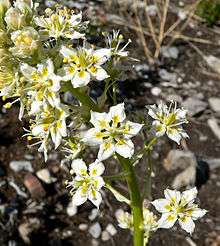Toxicoscordion paniculatum
| Toxicoscordion paniculatum | |
|---|---|
 | |
| near Robbers Roost, Spring Mountains, southern Nevada | |
| Scientific classification | |
| Kingdom: | Plantae |
| (unranked): | Angiosperms |
| (unranked): | Monocots |
| Order: | Liliales |
| Family: | Melanthiaceae |
| Genus: | Toxicoscordion |
| Species: | T. paniculatum |
| Binomial name | |
| Toxicoscordion paniculatum (Nutt.) Rydb.[1] | |
| Synonyms[1] | |
Toxicoscordion paniculatum is a species of flowering plant known by the common names foothill deathcamas and sand-corn. It is widely distributed across much of the western United States, especially in the mountains and deserts of the Great Basin region west of the Rocky Mountains. It grows in many types of habitat, including sagebrush plateau, grasslands, forests, and woodlands, etc.[2][3][4]
Toxicoscordion paniculatum is a perennial wildflower growing from a brown or black bulb up to 5 centimeters long by 3 wide. The stem grows up to 70 centimeters long. The leaves are linear in shape, measuring up to 50 centimeters long. Most of the leaves are at the base of the stem and there may be a few reduced leaves above. The inflorescence is an open panicle of flowers, becoming dense at the tip. The panicle contains up to 80 flowers, most of which are bisexual; some flowers at the end of branches and near the base of the panicle are only staminate (male), or are sterile. Each flower has six tepals, the inner three being slightly larger than the outer, measuring about 3 to 6 millimeters in length. The tepals are cream-colored, each with a yellowish green gland at the base. The fruit is a capsule 1 or 2 centimeters long.[2]
This plant is toxic to animals, but livestock generally avoid it because it is unpalatable.[5] Cases of human poisoning by ingestion of the bulbs have been documented as well.[5][6]
| Wikimedia Commons has media related to Toxicoscordion paniculatum. |
References
- 1 2 "Toxicoscordion paniculatum", World Checklist of Selected Plant Families, Royal Botanic Gardens, Kew, retrieved 2012-04-22
- 1 2 Flora of North America, Zigadenus paniculatus (Nuttall) S. Watson, Botany (Fortieth Parallel). 343. 1871. Foothill death camas, sand-corn
- ↑ Biota of North America Program 2014 county distribution map
- ↑ Calflora taxon report, University of California @ Berkeley, Toxicoscordion paniculatum (Nutt.) Rydb. foothill deathcamas
- 1 2 US Forest Service Fire Ecology
- ↑ Peterson, M. C. and G. J. Rasmussen. (2003). Intoxication with foothill camas (Zigadenus paniculatus). J Toxicol Clin Toxicol. 41:1 63-5.
External links
- Jepson Manual Treatment
- United States Department of Agriculture Plants Profile, Zigadenus paniculatus
- Burke Museum of Natural History and Culture, University of Washington, Toxicoscordion paniculatum many color photos plus Washington State distribution map
- Calphotos Photo gallery, University of California @ Berkeley, Zigadenus paniculatus
- Wildflowers of the United States, Foothill Death Camas, Foothills Deathcamas, Panicled Death Camas, Sand-corn - Toxicoscordion paniculatum color photos
- Southwest Colorado Wildflowers, Anticlea & Toxicoscordion - color photos of several species